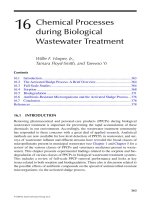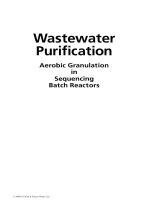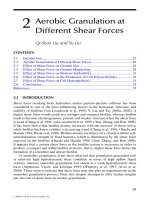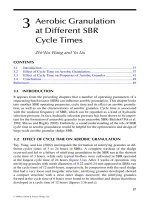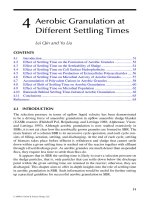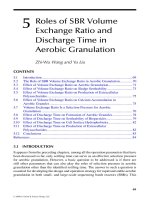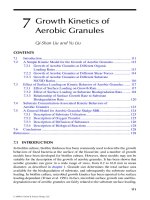Wastewater Purification: Aerobic Granulation in Sequencing Batch Reactors - Chapter 16 ppt
Bạn đang xem bản rút gọn của tài liệu. Xem và tải ngay bản đầy đủ của tài liệu tại đây (450.95 KB, 13 trang )
287
16
Improved Stability
of Aerobic Granules
by Selecting
Slow-Growing Bacteria
Yu Liu and Zhi-Wu Wang
CONTENTS
16.1 Introduction 287
16.2 Improved Stability of Aerobic Granules by Selecting Slow-Growing
Nitrifying Bacteria 288
16.3 Improved Stability of Aerobic Granules by Selecting Slow-Growing
P- or Glycogen-Accumulating Organisms 294
16.4 Improved Stability of Aerobic Granules by Selecting Aged
Aerobic Granules 296
16.5 Conclusions 296
References 298
16.1 INTRODUCTION
Thereisevidenceshowingthatthestabilityofaerobicgranulesispoorerthanthatof
anaerobic granules developed in upow anaerobic sludge blanket (UASB) reactors
(Morgenrothetal.1997;Pengetal.1999;ZhuandLiu1999).Experimentalresults
fromtwopilotplantsoperatedassequencingbatchbubblecolumnsdemonstrated
the feasibility of the aerobic granulation technology in treating real industrial waste-
water;however,abigconcernremainsgranulestability,aswellastheeconomic
competitiveness (Inizan et al. 2005). Obviously, the poor stability of aerobic granules
wouldlimititsapplicationinwastewatertreatmentpractice.
The instability of aerobic granules is probably due to the fact that aerobic bacte-
ria can grow much faster than anaerobic bacteria do. In fact, the stability of biolm is
closelyrelatedtothegrowthrateofbacteria,thatis,thehighergrowthrateofbacteria
resulted in a weaker structure of biolm (Tijhuis, van Loosdrecht, and Heijnen 1995;
Y.Liu1997;Kwoketal.1998).Todate,thequestionofhowtoimprovethestability
ofaerobicgranulesremainsunanswered.Therefore,thischapterexploresamicro-
bial selection-based strategy for improving the stability of aerobic granules. This
wouldbeveryusefulforthedevelopmentofafull-scaleaerobicgranularsludge
sequencing batch reactor (SBR) for wastewater treatment.
53671_C016.indd 287 10/2/07 3:07:05 PM
© 2008 by Taylor & Francis Group, LLC
© 2008 by Taylor & Francis Group, LLC
288 Wastewater Purification
16.2 IMPROVED STABILITY OF AEROBIC GRANULES BY
SELECTING SLOW-GROWING NITRIFYING BACTERIA
Under hydrodynamic conditions, the growth of aerobic granules after the initial cell-
to-cellattachmentisthenetresultofinteractionbetweenbacterialgrowthanddetach-
ment, while the balance between growth and detachment processes in turn leads to
anequilibriumorstablegranulesize(Y.LiuandTay2002).Thus,sizeevolution
of the microbial aggregates can be used to describe the growth of granular sludge.
Figure16.1showstheevolutionofmicrobialaggregatesintermsofsizeobservedat
different substrate N/COD ratios. It can be seen that the size of microbial aggregates
increases gradually and nally stabilizes. According to the granular growth curves
shown in gure 16.1, the aerobic granulation process can be categorized in three
phases, that is, the acclimation or lag phase, granulation, and maturation, indicated
byastablegranulesizeinthefourreactors.
The specic growth rate (µ
d
)bysizeofmicrobialaggregatescanbedenedas:
M
D
D$ DT
$
(16.1)
in which D is the mean size of the microbial aggregates, and t is operation time. In
thegranulationphase,asshowningure16.1,integratingequation16.1gives:
ln $T
D
M constant (16.2)
Hence, the observed size-dependent specic growth rate of microbial aggregate can
be determined from the slope of the straight line described by equation 16.2. It should
bepointedoutthatthisapproachhasbeensuccessfullyemployedtoestimatethe
Time (days)
0 102030405060
Bioparticle Mean Size (mm)
0.0
0.7
1.4
2.1
Acclimation Granulation Maturation
FIGURE 16.1 Changesinsizeofmicrobialaggregates.D: substrate N/COD ratio of
5/100; $:10/100;
d
:20/100;
c
:30/100.(DatafromLiu,Y.,Yang,S.F.,andTay,J.H.2004.
J Biotechnol 108: 161–169.)
53671_C016.indd 288 10/2/07 3:07:09 PM
© 2008 by Taylor & Francis Group, LLC
© 2008 by Taylor & Francis Group, LLC
Improved Stability of Aerobic Granules by Selecting Slow-Growing Bacteria 289
growth rates of biolms and anaerobic granules (Y. Liu 1997; Yan and Tay 1997).
Figure 16.2 shows the effect of substrate N/COD ratio on µ
d
.Itisobviousthatahigher
substrate N/COD ratio results in a lower specic growth rate of aerobic granules.
AccordingtoY.Liu,Yang,andTay(2004),theoverallactivityofthehetero-
trophicpopulationinstableaerobicgranulescanbequantiedbyitsspecicoxygen
utilization rate (SOUR)
H
, while the overall nitrifying activity is represented by the
sumoftheactivitiesofammoniaoxidizerandnitriteoxidizer,namely(SOUR)
N
.
The relative activity of the nitrifying population over the heterotrophic population in
aerobic granules developed at different substrate N/COD ratios is shown in gure 16.2.
The (SOUR)
N
/(SOUR)
H
ratio exhibits an increasing trend with the increase of sub-
strate N/COD ratio. It has been reported that the activity distribution of the nitri
-
fying population over the heterotrophic population in biolms was proportionally
related to the relative abundance of two populations under given conditions (Moreau
et al. 1994). Figure 16.3 further indicates that the increased (SOUR)
N
/(SOUR)
H
ratio
would result in a lower observed growth rate of aerobic granules and an improved
cell surface hydrophobicity; gure 16.4 and gure 16.5 reveal that aerobic granules
withlowgrowthratehavesmallersizeandmorecompactstructure.Ascanbeseen
in gure 16.6, both specic gravity and the sludge volume index (SVI) of aerobic
granules are closely correlated to the cell surface hydrophobicity, that is, high cell
surfacehydrophobicityleadstoacompactstructureoftheaerobicgranule.
Itappearsfromgure16.1thataerobicgranulationisagradualratherthaninstant
processfromdispersedsludgetomatureaerobicgranuleswithastablesize.The
acclimation phase observed in gure 16.1 implies that a newly inoculated culture does
notbegingrowingimmediately,andaperiodofabout10daysisrequiredforbacteria
toadopttoanewenvironmentinsteadofgrowth.Theobservedgrowthratebysize
andmeansizeatequilibriumofaerobicgranulesarecloselyrelatedtothesubstrate
N/COD ratio, that is, higher substrate N/COD ratio results in smaller granules with
FIGURE 16.2 Effect of substrate N/COD ratio on µ
d
(D)and(SOUR)
N
/(SOUR)
H
($)
ofaerobicgranules.(DatafromLiu,Y.,Yang,S.F.,andTay,J.H.2004.JBiotechnol
108: 161–169.)
53671_C016.indd 289 10/2/07 3:07:10 PM
© 2008 by Taylor & Francis Group, LLC
© 2008 by Taylor & Francis Group, LLC
290 Wastewater Purification
lower growth rate (gure 16.2). Figure 16.2 also reveals that the nitrifying population
inaerobicgranulesisenrichedwiththeincreaseofthesubstrateN/CODratio.Asa
result, the heterotrophs in aerobic granules become less and less dominant at high
substrate N/COD ratio. It seems that the high substrate N/COD ratio is an important
factor that selects nitrifying population. Since the growth of nitrifying bacteria is
much slower than heterotrophs (Sharma and Ahlert 1977), aerobic granules may offer
aprotectivematrixforthenitrifyingpopulationtogrowonwithouttheriskofbeing
washedoutofthesystem.
(SOUR)
N
/(SOUR)
H
0.1 0.2 0.3 0.4 0.5 0.6 0.7
μ
d
(d
–1
)
0.03
0.04
0.05
0.06
0.07
0.08
0.09
0.10
0.11
Cell Hydrophobicity (%)
68
72
76
80
84
88
92
FIGURE 16.4 Effect of µ
d
onstablegranulesize.(DatafromLiu,Y.,Yang,S.F.,and
Tay, J. H. 2004. JBiotechnol108: 161–169.)
(SOUR)
N
/(SOUR)
H
0.1 0.2 0.3 0.4 0.5 0.6 0.7
+
d
(d
-1
)
0.03
0.04
0.05
0.06
0.07
0.08
0.09
0.10
0.11
Cell hydrophobicity (% )
68
72
76
80
84
88
92
+
d
( ) and cell hydrophobicity
(
) of aerobic granules
FIGURE 16.3 Effect of (SOUR)
N
/(SOUR)
H
on µ
d
(F) and cell hydrophobicity (&)ofaerobic
granules. (Data from Liu, Y., Yang, S. F., and Tay, J. H. 2004. JBiotechnol108: 161–169.)
53671_C016.indd 290 10/2/07 3:07:40 PM
© 2008 by Taylor & Francis Group, LLC
© 2008 by Taylor & Francis Group, LLC
Improved Stability of Aerobic Granules by Selecting Slow-Growing Bacteria 291
It appears from gure 16.3 that the specic growth rate of aerobic granules
is closely related to the distribution of the nitrifying population over the hetero
-
trophic population in aerobic granules. This suggests that the enriched nitrifying
populationinaerobicgranulesismainlyresponsiblefortheloweredgrowthrateof
aerobic granules developed at high substrate N/COD ratios. In a study of anaerobic
granulation, Yan and Tay (1997) thought that if granulation is purely the result of
bacterial aggregation and growth and the granule formed is ideal, a relationship
betweenspecicgrowthratebysizeandthatbybiomasscanbederivedasfollows:
!
FIGURE 16.5 Effect of µ
d
on specic gravity (D)andSVI($)ofaerobicgranules.(Data
from Liu, Y., Yang, S. F., and Tay, J. H. 2004. JBiotechnol108: 161–169.)
" !
FIGURE 16.6 Relationships of specic gravity (D)andSVI($)tocellhydrophobicity
ofaerobicgranules.(DatafromLiu,Y.,Yang,S.F.,andTay,J.H.2004.JBiotechnol
108: 161–169.)
53671_C016.indd 291 10/2/07 3:07:43 PM
© 2008 by Taylor & Francis Group, LLC
© 2008 by Taylor & Francis Group, LLC
292 Wastewater Purification
M
P
R
P
R
M
GD
8
D8
DT
$
D$
DT $
D$
DT
¥
§
¦
´
¶
µ
11
6
6
3
1
3
3
3
(16.3)
in which µ
g
isspecicgrowthratebybiomass(gbiomassg
–1
biomass d
–1
), X is bio-
mass concentration of granules, and S isdensityofgranules.Accordingtoequation
16.3,thespecicgrowthratebysizecanbeconvertedtothespecicgrowthrateby
biomass. The respective µ
g
value of aerobic granules developed at substrate N/COD
ratios of 5/100, 10/100, 20/100, and 30/100 is 0.3, 0.21, 0.15, and 0.12 d
–1
(Y. Liu,
Yang,andTay2004).Theµ
g
values of nitrifying population-enriched aerobic
granulesarecomparablewiththosefoundinnitrifyingbiolms(Oga,Suthersan,
and Ganczarczyk 1991).
Aerobicgranuleshavebeenconsideredtohaverelativelylowstability(Morgenroth
et al. 1997; Zhu and Liu 1999). Obviously, the poor stability of aerobic granules will
limit their application in wastewater treatment. The cause behind the poor stability
ofaerobicgranuleswouldbeduetothefastgrowthofheterotrophicbacteriathat
dominate aerobic granules. The nitrifying population grows much more slowly than
heterotrophs, while the physical structure of nitrifying biolms is much stronger than
heterotrophic biolms (Oga, Suthersan, and Ganczarczyk 1991). Figure 16.3 reveals
thattheobservedgrowthrateofaerobicgranulescanbesignicantlyloweredby
enrichment of the nitrifying population, and this can be realized through properly
controllingthesubstrateN/CODratio.Ascanbeseeningures16.4and16.5,the
loweredgrowthrateinturnresultsinasmallersizeofaerobicgranules,butwitha
higherspecicgravity,indicatingacompact,strongmicrobialstructure.Itfurther
appearsfromgure16.7thatlargegranuleshavealoosestructure.Thisobservationis
consistentwiththosefoundinbiolms,thatis,thecompactnessofbiolmisreduced
withtheincreaseinbiolmthickness(Kwoketal.1998;Y.LiuandTay2002).These
allpointtothefactthatthestructuralstabilityofaerobicgranulescanbesignicantly
improved by selecting slow-growing nitrifying bacteria.
Aerobicgranulationisknownasamicrobialself-immobilizationprocessthat
shouldbesimilartothegrowthofbiolm(Y.LiuandTay2002).Inastudyof
biolms,thereisevidencethatthestrengthofbiolmsisnegativelyrelatedtothe
growth rate of microorganisms (Tijhuis, van Loosdrecht, and Heijnen 1995). Kwok
etal.(1998)reportedthatthebiolmdensitydecreasedasthegrowthrateincreased,
whilethedensityofnitrifyingbiolmwasfoundtobehigherthanthatofhetero
-
trophic biolm (Oga, Suthersan, and Ganczarczyk 1991). This is consistent with the
results reported in gures 16.4 and 16.5. Similarly, in the anaerobic granulation pro-
cess,itwasalsoobservedthatahighbiomassgrowthrateledtoareducedstrength
of anaerobic granules, that is, partial loss of structural integrity and disintegration
occurs at high biomass growth rates (Morvai, Mihaltz, and Czako 1992; Quarmby
andForster1995).Itbecomesclearthatthehighobservedgrowthratewouldencour-
agetheoutgrowthofaerobicgranules,leadingtoarapidincreaseinthesizeofthe
granules,aswellasaloosestructurewithlowbiomassdensity.
As discussed earlier, a high substrate N/COD ratio appears to favor the selection
of nitrifying bacteria in aerobic granules, thereby one possible operation strategy
53671_C016.indd 292 10/2/07 3:07:45 PM
© 2008 by Taylor & Francis Group, LLC
© 2008 by Taylor & Francis Group, LLC
Improved Stability of Aerobic Granules by Selecting Slow-Growing Bacteria 293
thatcanhelptoimprovethestabilityofaerobicgranulesistoselectslow-growing
nitrifying bacteria in aerobic granules by controlling the feed N/COD ratio.
Amushroom-likestructurewasobservedinaerobicgranulescultivatedatthesub
-
strateN/CODratioof20/100(gure16.8a),andasimilarstructurewasalsoobserved
ingranulesdevelopedatthesubstrateN/CODratioof30/100.However,theaerobic
granules developed at the substrate N/COD ratio of 5/100 displayed a nonclustered
structure. CLSM (confocal laser scanning microscope) images of FISH (uorescent
in situ hybridization) further revealed that the nitrifying population was dominant
in the clusters (gure 16.9). Figure 16.8b shows that the top layer mainly consists
of cocci-shaped bacteria, while rod-shaped bacteria are dominant subsequently. Tay
et al. (2002) also reported that the nitrifying population was mainly located at a
depthof70to100µmfromthesurfaceofthegranule.Infact,previousresearch
showed that biolm of mixed bacterial communities formed thick layers consisting
of differentiated mushroom-like structures (Costerton et al. 1994), which are very
similar to that observed in gure 16.8a. Figure 16.2 shows that the relative abundance
ofthenitrifyingpopulationovertheheterotrophicpopulationintheaerobicgranules
grownatthesubstrateN/CODratioof5/100isverylowascomparedtothegranules
developedathighsubstrateN/CODratios.AthighsubstrateN/CODratio,competi
-
tion between nitrifying and heterotrophic populations on nutrients is signicant.
It has been demonstrated that biolm can form the mushroom-like structure
by simply changing the diffusion rate, that is, the biolm structure is largely deter
-
mined by nutrient concentration (Wimpenny and Colasanti 1997). In fact, bacteria
may sense and move towards nutrients (Prescott, Harley, and Klein 1999). Because
of their slow growth rate, the mushroom-like structure would result from the demand
ofthenitrifyingpopulationonnutrients,anditinturnensuresthatthenitrifying
population in aerobic granules can maximize access to nutrients. As Watnick and
Kolter(2000)noted,inmixedbiolms,bacteriadistributethemselvesaccordingto
whocansurvivebestintheparticularmicroenvironment,andthehighcomplexity
Stable Bioparticle Mean Size (mm)
0.2 0.4 0.6 0.8 1.0 1.2 1.4 1.6 1.8 2.0 2.2
Specific Gravity
1.01
1.02
1.03
1.04
1.05
1.06
1.07
FIGURE 16.7 Relationshipbetweenstablemeansizeandspecicgravityofaerobic
granules.(DatafromLiu,Y.,Yang,S.F.,andTay,J.H.2004.JBiotechnol108: 161–169.)
53671_C016.indd 293 10/2/07 3:07:46 PM
© 2008 by Taylor & Francis Group, LLC
© 2008 by Taylor & Francis Group, LLC
294 Wastewater Purification
ofamicrobialcommunitywouldbebenecialtoitsstability.Thesendingsseem
to indicate that the mushroom-like structure of densely slow-growing nitrifying
bacteriawouldcontributetothestabilityofaerobicgranulesdevelopedathighsub
-
strateN/CODratios.Inastudyofactivatedsludgeocstability,asimilarremark
wasalsomadebyWilen,Jin,andLant(2003).Consequently,theorganizationofdif
-
ferentmicrobialpopulationsmayhaveaneffectonthestabilityofaerobicgranules.
16.3 IMPROVED STABILITY OF AEROBIC GRANULES
BY SELECTING SLOW-GROWING P- OR
GLYCOGEN-ACCUMULATING ORGANISMS
It is clear that selection of slow growing organisms can improve the density and
stabilityofaerobicgranules.deKreukandvanLoosdrecht(2004)thoughtthat
to lower the growth rate of organisms in aerobic granules, easily biodegradable
EHT = 30.00 kV WD = 19 mm Mag = 5.00 K X
Photo No. = 2198 Detector = SE11 µm
EHT = 30.00 kV WD = 19 mm Mag = 130 X
Photo No. = 2177 Detector = SE120 µm
B
A
FIGURE 16.8 Mushroom-likestructureofanaerobicgranuledevelopedatasubstrate
N/CODratioof20/100.(FromLiu,Y.,Yang,S.F.,andTay,J.H.2004.JBiotechnol
108: 161–169. With permission)
53671_C016.indd 294 10/2/07 3:07:49 PM
© 2008 by Taylor & Francis Group, LLC
© 2008 by Taylor & Francis Group, LLC
Improved Stability of Aerobic Granules by Selecting Slow-Growing Bacteria 295
substrate needs to be converted to slowly degradable organics, namely microbial
storage polymers. It has been known that phosphate- or glycogen-accumulating
organismscanperformsuchaconversionofexternalorganiccarbontostorage
polymers. The experimental work by de Kreuk and van Loosdrecht (2004) showed
that the selection or enrichment of P-accumulating or glycogen-accumulating organ
-
isms in aerobic granules indeed would lead to stable aerobic granules.
Heterotrophicbacteriagrowingontheslowlybiodegradablestoragepolymers,
such as poly-
C-hydroxybutyrate(PHB)orglycogen,mayhavesmallergrowthrates
ascomparedtothosegrowingoneasilybiodegradableorganicsubstrates(Cartaetal.
2001).Forpromotingtheconversionofanexternalcarbonsourcetothestoragepoly
-
mers,alonganaerobic feedingperiodhasbeenoftenpracticedfollowedbyanaerobic
reactionphase.ByimplementingsuchanoperationstrategyinanSBR,selectionof
slow-growing P- or glycogen-accumulating organisms would be expected (de Kreuk
andvanLoosdrecht2004).Onthecontrary,Li,Kuba,andKusuda(2006)foundthat
whentheaerobicllingtimewasextendedfrom5to30minutes,thedenseandcom
-
pactaerobicgranulesweregraduallyshiftedintoalightandlooselamentousgranular
structure,thatis,theextensionoftheaerobicllingtimeeventuallyledtoinstability
andthefailureoftheaerobicgranularsludgeSBR.Ithasbeenreportedthatwhen
dosage of external phosphate was no longer available, P-accumulating organisms
tendedtograduallydisappearandbereplacedbyglycogen-accumulating organisms
in aerobic granules. Even in this case, the characteristics of aerobic granules seemed
nottochangesignicantly,andsmooth,denseandstableaerobicgranulescouldbe
maintained in the SBR (de Kreuk and van Loosdrecht 2004).
Sofar,evidenceshowsthatahighdissolvedoxygen(DO)concentrationis
necessary for stable aerobic granulation in SBRs (see chapter 8). However, low oxygen
FIGURE 16.9 Distribution of ammonium-oxidizing bacteria (AOB) in an aerobic granule.
WhitecolorrepresentsAOB.(CourtesyofDr.V.Ivanov,NanyangTechnologicalUniversity,
Singapore.)
53671_C016.indd 295 10/2/07 3:07:50 PM
© 2008 by Taylor & Francis Group, LLC
© 2008 by Taylor & Francis Group, LLC
296 Wastewater Purification
concentration is desirable in order to make aerobic granulation technology economi-
cally competitive over the conventional activated sludge processes. According to the
substrate availability, the operation of an SBR can be roughly divided into two dis
-
tinctphasesorperiods,thatis,feastandfamineperiods(Tay,Liu,andLiu2001;Q S.
Liu2003;deKreukandvanLoosdrecht2004).Theoretically,thefeastperiodisthe
periodinwhichtheexternalenergysource(e.g.substrate)isavailableformicrobial
growth, while after depletion of the external substrate, the culture comes to the famine
phase in which only internally stored polymers are available for microbial use.
Y.Q.LiuandTay(2006)lookedintothepossibilityofvariableaerationinan
aerobicgranularsludgeSBR,andtheyfoundthataftertheaerationratewasreduced
from 1.66 to 0.55 cm s
–1
in the famine period, the settleability of aerobic granules in
the SBR with reduced aeration was the same as that of aerobic granules in the SBR
with constant aeration rate of 1.66 cm s
–1
.Itisapparentfromgure16.10thatreduc-
ingtheaerationrateduringthefamineperiodwouldnothaveasignicanteffect
on the stable operation of the aerobic granular sludge reactor, whereas the aeration
rate in the feast period is crucial for the stable operation of the aerobic granular
sludge.Obviously,byimplementinganoperationstrategywithreducedaerationin
thefaminephase,asignicantreductioninenergyconsumptionwouldbeexpected
inaerobicgranularsludgeSBRs.
16.4 IMPROVED STABILITY OF AEROBIC GRANULES
BY SELECTING AGED AEROBIC GRANULES
Itcanbeseenintheabovediscussionthatselectionofslow-growingbacteriacansig-
nicantlyimprovethestabilityofaerobicgranulesdevelopedinSBRs.Intermsofthe
processoperation,alongsolidsretentiontime(SRT)meansalowspecicmicrobial
growthrate.Basedonthisbasicidea,Li,Kuba,andKusuda(2006)triedtocontrol
thegrowthrateofaerobicgranulesbyspecicallyselectingyoungoragedgranules.
Whenyoungaerobicgranuleswereregularlyremoved,moreandmoreagedgranules
wouldaccumulateinthesystem,leadingtoareducedbiodiversityofthoseremaining
aerobicgranules.Ithasbeenthoughtthatthereducedbiodiversityduetoenriched
aged aerobic granules would help to select slow-growing bacteria and thus increase the
stabilityofaerobicgranules(Li,Kuba,andKusuda2006).Alongwiththetakeoutof
youngaerobicgranules,granulesremainingintheSBRwouldbecomemoreaged,and
subsequentlyaremarkableincreaseinthegranuleashcontentwasobserved(Li,Kuba,
andKusuda2006).Iftheagedaerobicgranules wereremovedfromSBR,Li,Kuba,
and Kusuda (2006) found that large, loose aerobic granules appeared and dominated
the system. This may be due to the fact that lamentous microorganisms grew exces
-
sively in the system, eventually leading to instability of aerobic granules.
16.5 CONCLUSIONS
Thestabilityofaerobicgranulesiskeytolong-termandstableoperationofaerobic
granular sludge bioreactors. In this respect, the selection and enrichment of
slow-growing organisms, such as nitrifying bacteria, P-accumulation and glycogen-
accumulating organisms, appears to be the most feasible engineering strategy.
53671_C016.indd 296 10/2/07 3:07:50 PM
© 2008 by Taylor & Francis Group, LLC
© 2008 by Taylor & Francis Group, LLC
Improved Stability of Aerobic Granules by Selecting Slow-Growing Bacteria 297
53671_C016.indd 297 10/2/07 3:07:52 PM
© 2008 by Taylor & Francis Group, LLC
© 2008 by Taylor & Francis Group, LLC
SVI (mL g
–1
)
0
20
40
60
80
100
120
140
Biomass Concentration (g L
–1
)
0
2
4
6
8
"
! #$
FIGURE 16.10 SVI, biomass conc e ntration, and average particle size of aer obic granular
sludge i n two SBRs operated at (
c
) reduced aeration rate of 0.55 cm s
–1
and ( )constant
aeration rate of 1.66 cm s
–1
.(DatafromLiu,Y.Q.andTay,J.H.2006.JBiotechnol
124 : 338– 346. )
298 Wastewater Purification
REFERENCES
Carta, F., Beun, J. J., van Loosdrecht, M. C. M., and Heijnen, J. J. 2001. Simultaneous
storageanddegradationofPHBandglycogeninactivatedsludgecultures.Water Res
35: 2693–2701.
Costerton, J. W., Lewandowski, Z., Debeer, D., Caldwell, D., Korber, D., and James, G. 1994.
Biolms, the customized microniche. J Bacteriol 176: 2137–2142.
de Kreuk, M. K. and van Loosdrecht, M. C. M. 2004. Selection of slow growing organisms as
ameansforimprovingaerobicgranularsludgestability.Water Sci Technol 49: 9–17.
Inizan,M.,Freval,A.,Cigana,J.,andMeinhold,J.2005.Aerobicgranulationinasequencing
batch reactor (SBR) for industrial wastewater treatment. Water Sci Technol 52: 335–343.
Kwok,W.K.,Picioreanu,C.,Ong,S.L.,vanLoosdrecht,M.C.M.,Ng,W.J.,andHeijnen,J.J.
1998.Inuenceofbiomassproductionanddetachmentforcesonbiolmstructuresina
biolmairliftsuspensionreactor.Biotechnol Bioeng 58: 400–407.
Li, Z. H., Kuba, T., and Kusuda, T. 2006. Selective force and mature phase affect the stability
of aerobic granule: An experimental study by applying different removal methods of
sludge. Enzyme Microb Technol 39: 976–981.
Liu,Q S.2003.Aerobicgranulationinasequencingbatchreactor.Ph.D.thesis,Nanyang
Technological University, Singapore.
Liu, Y. (1997) Estimating minimum xed biomass concentration and active thickness of
nitrifying biolm. JEnvironEng123: 198–202.
Liu,Y.andTay,J.H.2002.Theessentialroleofhydrodynamicshearforceintheformation
of biolm and granular sludge. Water Res 36: 1653–1665.
Liu,Y.,Yang,S.F.,andTay,J.H.2004.Improvedstabilityofaerobicgranulesbyselecting
slow-growing nitrifying bacteria. JBiotechnol108: 161–169.
Liu,Y.Q.andTay,J.H.2006.Variableaerationinsequencingbatchreactorwithaerobic
granular sludge. JBiotechnol124: 338–346.
Moreau,M.,Liu,Y.,Capdeville,B.,Audic,J.M.,andCalvez,L.1994.Kineticbehaviorof
heterotrophic and autotrophic biolms in wastewater treatment processes. Water Sci
Technol 29: 385–391.
Morgenroth,E.,Sherden,T.,vanLoosdrecht,M.C.M.,Heijnen,J.J.,andWilderer,P.A.
1997. Aerobic granular sludge in a sequencing batch reactor. Water Res 31: 3191–3194.
Morvai,L.,Mihaltz,P.,andCzako,L.(1992)Kineticbasisofanewstart-upmethodtoensure
therapidgranulationofanaerobicsludge.Water Sci Technol 25: 113–122.
Oga,T.,Suthersan,S.,andGanczarczyk,J.J.1991.Somepropertiesofaerobicbiolms.
Environ Technol 12: 431–440.
Peng,D.C.,Bernet,N.,Delgenes,J.P.,andMoletta,R.1999.Aerobicgranularsludge:Acase
report. Water Res 33: 890–893.
Prescott,L.,Harley,J.,andKlein,D.1999.Microbiology. Boston: McGraw-Hill.
Quarmby,J.andForster,C.F.1995.AnexaminationofthestructureofUASBgranules.
Water Res 29: 2449–2454.
Sharma,B.andAhlert,R.C.1977.Nitricationandnitrogenremoval.Water Res 11: 897–925.
Tay,J.H.,Liu,Q S.,andLiu,Y.2001.Theeffectsofshearforceontheformation,structure
andmetabolismofaerobicgranules.Appl Microbiol Biotechnol 57: 227–233.
Tay,J.H.,Ivanov,V.,Pan,S.,andTay,S.T.L.2002.Speciclayersinaerobicallygrown
microbial granules. Lett Appl Microbiol 34: 254–257.
Tijhuis,L.,vanLoosdrecht,M.C.M.,andHeijnen,J.J.1995.Dynamicsofbiolmdetach
-
ment in biolm airlift suspension reactors. Biotechnol Bioeng 45: 481–487.
Watnick, P. and Kolter, R. 2000. Biolm, city of microbes. J Bacteriol 182: 2675–2679.
Wilen, B. M., Jin, B., and Lant, P. 2003. The inuence of key chemical constituents in
activated sludge on surface and occulating properties. Water Res 37: 2127–2139.
53671_C016.indd 298 10/2/07 3:07:53 PM
© 2008 by Taylor & Francis Group, LLC
© 2008 by Taylor & Francis Group, LLC
Improved Stability of Aerobic Granules by Selecting Slow-Growing Bacteria 299
Wimpenny,J.W.T.andColasanti,R.1997.Aunifyinghypothesisforthestructureofmicro-
bial biolms based on cellular automaton models. FEMS Microbiol Ecol 22: 1–16.
Yan,Y.G.andTay,J.H.1997.CharacterisationofthegranulationprocessduringUASB
start-up. Water Res 31: 1573–1580.
Zhu, J. and Liu, C. 1999. Cultivation and physico-chemical characteristics of granular acti
-
vated sludge in alternating anaerobic/aerobic process. ChinJEnvironSci20: 38–41.
53671_C016.indd 299 10/2/07 3:07:54 PM
© 2008 by Taylor & Francis Group, LLC
© 2008 by Taylor & Francis Group, LLC

